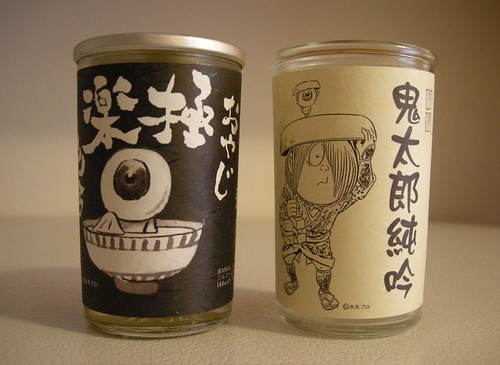
I regretfully report that Anders, aka Skankynavia and Packaging Whore columnist, is on sabbatical for the next few weeks, and will be returning in mid-March. Sorry, Martians! I know you all adore his posts, but our resident SkankMaster will be hibernating for the rest of the winter. It's chilly up there in SkankyLand.
I'll be filling in for him in the meantime. Hooray!!! Please allow me to revert to my childhood self and delve into the geeky world of anime fandom here today. I bring to you the one-cup sake by
Chiyomusubi brewery. It's
GeGeGe no Kitaro!!!
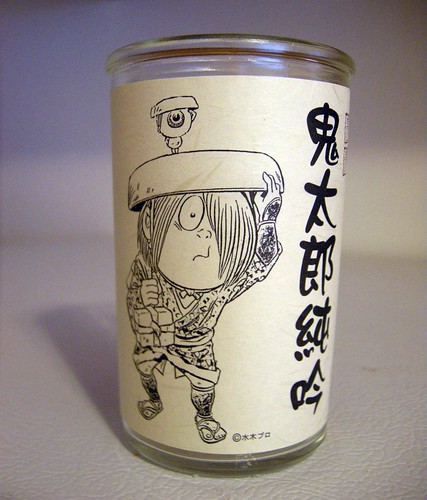
I confess that the only reason I bought these were for its labels.
GeGeGe no Kitaro (ゲゲゲの鬼太郎) is a manga created by
Shigeru Mizuki from 1959. It's all about a little ghost boy named Kitaro, and his quirky world full of goblins and "Medama Oyaji" (Kitaro's father, literally a walking eyeball). See Dad on top of Kitaro's hat? He can be interpreted as Kitaro's right eye. So perverse.
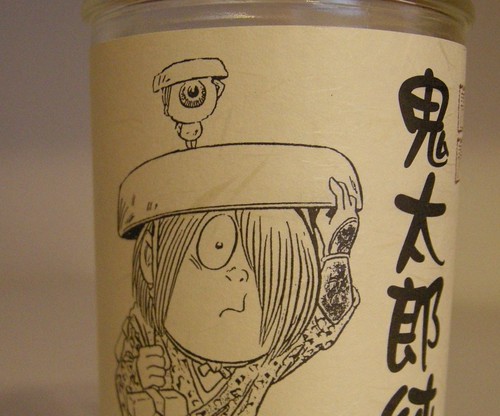
Chiyomusubi brewery even gave Eyeball Dad his own sake, called
Oyaji:

The one-cup sake packaging design deserves a Packaging Whore post in itself, although it gets a pretty bad rap by "serious" sake connoisseurs. They are simply individual 180ml cups of sake (a little less than an American "cup"), that are perfectly portable. Here is what Yoko says about the one-cup sake phenomenon (specifically by Ozeki brewery, creator of the one-cup):
According to Japanese wikipedia, the product was released on October 10, 1964 (the first day of the Tokyo Olympics) and revolutionized the way people drank sake. The slogan「いつでも、どこでも飲める」“Drink anywhere, anytime” was targeted to young people whose image of sake was not necessarily confined to the more traditional isshobin (bottle) or tokkuri (sake flask).
But the product didn’t really take off until 1967 when vending machines selling alcohol started to proliferate rapidly throughout Japan. It wasn’t a coincidence that 1967 was also the year that Japanese government added the current design of the 100 yen coin to their lineup of legal tender.
Pull-cap for easy opening.
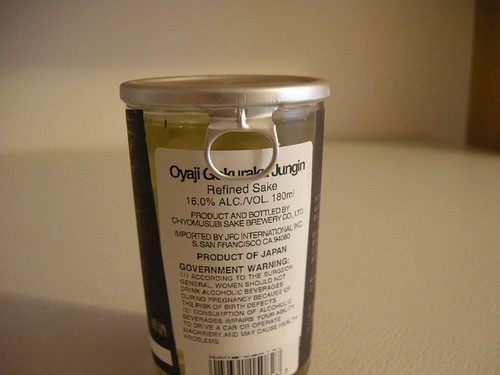 GeGeGe no Kitaro
GeGeGe no Kitaro went from a comic magazine page onto the television screen in 1968, then again in 1971, then resurrected once again in 1985. I grew up watching the 1985 version, in color, and sharper images. I'll never forget the opening song for the show, which is as ubiquitous in Japan as the
Doraemon song (another personal favorite).
I've dug up the opening segment from the 60's for your viewing pleasure:
http://www.youtube.com/watch?v=9boVDep-diw
Now compare it to the version I watched growing up (sorry no subtitles):
http://www.youtube.com/watch?v=RpZJjz8vrlI&feature=related
Now, the brewery must have paid an arm and a leg to get the rights to reproduce Kitaro onto their labels for these little one-cup sakes. But artist Mizuki is from Tottori, where the Chiyomusubi brewery is located, so this homage makes complete sense. It would be my fantasy equivalent to Heinz producing ketchup bottles with Andy Warhol labels on them (Andy is from Pittsburgh, where Heinz is headquartered). No, the
Heinz box he designed does not count.
Shigeru Mizuki himself is best known in Japan for the Kitaro series and is considered a master of the
yokai (ghost) genre. He was drafted into World War II, and has written a memoir about his service. It could not be a coincidence that the world he eventually created would be inhabited by ghosts and goblins. Mizuki himself made a cameo on Takashi Miike's film
The Great Yokai War in 2005.
How does the sake taste, you ask? I am no sake expert, but I found this sake to be full-bodied, floral, with a dry finish. It is a
junmai ginjo, which
thanks to Yoko's post on premium sakes, we now know is pure rice wine, with only water added (no sugar, added alcohol, etc.), producing a much "bigger" sake. This sake tasted better cold, but I confess that I warmed mine up last night, as my apartment was freezing! Watch Urban Sake's
video reviews on these Kitaro sakes--Timothy is a "Sake Samurai" so I'll let him describe the sake himself.
I myself sported the Kitaro Hair for most of my 20s. I would always tell my Japanese hairstylist in Brooklyn to make me look like Kitaro. Seriously. Here I am in Spain 2006: dance party, greasy hair and all!
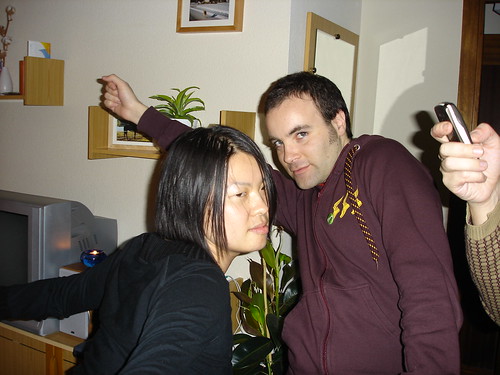
 I regretfully report that Anders, aka Skankynavia and Packaging Whore columnist, is on sabbatical for the next few weeks, and will be returning in mid-March. Sorry, Martians! I know you all adore his posts, but our resident SkankMaster will be hibernating for the rest of the winter. It's chilly up there in SkankyLand.
I'll be filling in for him in the meantime. Hooray!!! Please allow me to revert to my childhood self and delve into the geeky world of anime fandom here today. I bring to you the one-cup sake by Chiyomusubi brewery. It's GeGeGe no Kitaro!!!
I regretfully report that Anders, aka Skankynavia and Packaging Whore columnist, is on sabbatical for the next few weeks, and will be returning in mid-March. Sorry, Martians! I know you all adore his posts, but our resident SkankMaster will be hibernating for the rest of the winter. It's chilly up there in SkankyLand.
I'll be filling in for him in the meantime. Hooray!!! Please allow me to revert to my childhood self and delve into the geeky world of anime fandom here today. I bring to you the one-cup sake by Chiyomusubi brewery. It's GeGeGe no Kitaro!!!
 I confess that the only reason I bought these were for its labels. GeGeGe no Kitaro (ゲゲゲの鬼太郎) is a manga created by Shigeru Mizuki from 1959. It's all about a little ghost boy named Kitaro, and his quirky world full of goblins and "Medama Oyaji" (Kitaro's father, literally a walking eyeball). See Dad on top of Kitaro's hat? He can be interpreted as Kitaro's right eye. So perverse.
I confess that the only reason I bought these were for its labels. GeGeGe no Kitaro (ゲゲゲの鬼太郎) is a manga created by Shigeru Mizuki from 1959. It's all about a little ghost boy named Kitaro, and his quirky world full of goblins and "Medama Oyaji" (Kitaro's father, literally a walking eyeball). See Dad on top of Kitaro's hat? He can be interpreted as Kitaro's right eye. So perverse.
 Chiyomusubi brewery even gave Eyeball Dad his own sake, called Oyaji:
Chiyomusubi brewery even gave Eyeball Dad his own sake, called Oyaji:
 The one-cup sake packaging design deserves a Packaging Whore post in itself, although it gets a pretty bad rap by "serious" sake connoisseurs. They are simply individual 180ml cups of sake (a little less than an American "cup"), that are perfectly portable. Here is what Yoko says about the one-cup sake phenomenon (specifically by Ozeki brewery, creator of the one-cup):
According to Japanese wikipedia, the product was released on October 10, 1964 (the first day of the Tokyo Olympics) and revolutionized the way people drank sake. The slogan「いつでも、どこでも飲める」“Drink anywhere, anytime” was targeted to young people whose image of sake was not necessarily confined to the more traditional isshobin (bottle) or tokkuri (sake flask).
But the product didn’t really take off until 1967 when vending machines selling alcohol started to proliferate rapidly throughout Japan. It wasn’t a coincidence that 1967 was also the year that Japanese government added the current design of the 100 yen coin to their lineup of legal tender.
Pull-cap for easy opening.
The one-cup sake packaging design deserves a Packaging Whore post in itself, although it gets a pretty bad rap by "serious" sake connoisseurs. They are simply individual 180ml cups of sake (a little less than an American "cup"), that are perfectly portable. Here is what Yoko says about the one-cup sake phenomenon (specifically by Ozeki brewery, creator of the one-cup):
According to Japanese wikipedia, the product was released on October 10, 1964 (the first day of the Tokyo Olympics) and revolutionized the way people drank sake. The slogan「いつでも、どこでも飲める」“Drink anywhere, anytime” was targeted to young people whose image of sake was not necessarily confined to the more traditional isshobin (bottle) or tokkuri (sake flask).
But the product didn’t really take off until 1967 when vending machines selling alcohol started to proliferate rapidly throughout Japan. It wasn’t a coincidence that 1967 was also the year that Japanese government added the current design of the 100 yen coin to their lineup of legal tender.
Pull-cap for easy opening.
 GeGeGe no Kitaro went from a comic magazine page onto the television screen in 1968, then again in 1971, then resurrected once again in 1985. I grew up watching the 1985 version, in color, and sharper images. I'll never forget the opening song for the show, which is as ubiquitous in Japan as the Doraemon song (another personal favorite).
I've dug up the opening segment from the 60's for your viewing pleasure:
http://www.youtube.com/watch?v=9boVDep-diw
Now compare it to the version I watched growing up (sorry no subtitles):
http://www.youtube.com/watch?v=RpZJjz8vrlI&feature=related
Now, the brewery must have paid an arm and a leg to get the rights to reproduce Kitaro onto their labels for these little one-cup sakes. But artist Mizuki is from Tottori, where the Chiyomusubi brewery is located, so this homage makes complete sense. It would be my fantasy equivalent to Heinz producing ketchup bottles with Andy Warhol labels on them (Andy is from Pittsburgh, where Heinz is headquartered). No, the Heinz box he designed does not count.
Shigeru Mizuki himself is best known in Japan for the Kitaro series and is considered a master of the yokai (ghost) genre. He was drafted into World War II, and has written a memoir about his service. It could not be a coincidence that the world he eventually created would be inhabited by ghosts and goblins. Mizuki himself made a cameo on Takashi Miike's film The Great Yokai War in 2005.
How does the sake taste, you ask? I am no sake expert, but I found this sake to be full-bodied, floral, with a dry finish. It is a junmai ginjo, which thanks to Yoko's post on premium sakes, we now know is pure rice wine, with only water added (no sugar, added alcohol, etc.), producing a much "bigger" sake. This sake tasted better cold, but I confess that I warmed mine up last night, as my apartment was freezing! Watch Urban Sake's video reviews on these Kitaro sakes--Timothy is a "Sake Samurai" so I'll let him describe the sake himself.
I myself sported the Kitaro Hair for most of my 20s. I would always tell my Japanese hairstylist in Brooklyn to make me look like Kitaro. Seriously. Here I am in Spain 2006: dance party, greasy hair and all!
GeGeGe no Kitaro went from a comic magazine page onto the television screen in 1968, then again in 1971, then resurrected once again in 1985. I grew up watching the 1985 version, in color, and sharper images. I'll never forget the opening song for the show, which is as ubiquitous in Japan as the Doraemon song (another personal favorite).
I've dug up the opening segment from the 60's for your viewing pleasure:
http://www.youtube.com/watch?v=9boVDep-diw
Now compare it to the version I watched growing up (sorry no subtitles):
http://www.youtube.com/watch?v=RpZJjz8vrlI&feature=related
Now, the brewery must have paid an arm and a leg to get the rights to reproduce Kitaro onto their labels for these little one-cup sakes. But artist Mizuki is from Tottori, where the Chiyomusubi brewery is located, so this homage makes complete sense. It would be my fantasy equivalent to Heinz producing ketchup bottles with Andy Warhol labels on them (Andy is from Pittsburgh, where Heinz is headquartered). No, the Heinz box he designed does not count.
Shigeru Mizuki himself is best known in Japan for the Kitaro series and is considered a master of the yokai (ghost) genre. He was drafted into World War II, and has written a memoir about his service. It could not be a coincidence that the world he eventually created would be inhabited by ghosts and goblins. Mizuki himself made a cameo on Takashi Miike's film The Great Yokai War in 2005.
How does the sake taste, you ask? I am no sake expert, but I found this sake to be full-bodied, floral, with a dry finish. It is a junmai ginjo, which thanks to Yoko's post on premium sakes, we now know is pure rice wine, with only water added (no sugar, added alcohol, etc.), producing a much "bigger" sake. This sake tasted better cold, but I confess that I warmed mine up last night, as my apartment was freezing! Watch Urban Sake's video reviews on these Kitaro sakes--Timothy is a "Sake Samurai" so I'll let him describe the sake himself.
I myself sported the Kitaro Hair for most of my 20s. I would always tell my Japanese hairstylist in Brooklyn to make me look like Kitaro. Seriously. Here I am in Spain 2006: dance party, greasy hair and all!





Comments (7)
I bought an Oyaji cup a couple of years ago knowing absolutely nothing about Gegege no Kitaro. Simply because I like to collect the glasses. As long as the labels aren’t paper I’ll buy them sooner at later.
Last night I was looking for distinctive hanafuda (I only have a traditional set and a Mario set.) I got to one set and said, “OMG! The eyeball!”
I’ve been down the rabbit hole researching Gegege no Kitaro for a few hours now. 😁
didn’t know Kitaro. sad to see the YouTube’s have been taken down for copyright issues!
My buddy got one of these on a whim because we’ve never seen cup sake before, it was delicious!
Love the theme song comparison. I wish more Japanese cartoons from the 70s and 80s were played here in the U.S.
Also, there is a Shigeru Mizuki museum and store at Jindaiji (check out the last picture in this post I wrote up nearly 4 years ago!!!)
http://www.umamimart.com/2007/04/jindaiji/
I remember that post like it was yesterday! Crazy. I always wanted that bus.
I watched a few episodes of ‘Ge Ge Ge no Nyobo’, a TV series about Mizuki Shigeru and his wife which was a huge hit in Japan. Love those afternoon dramas. And love the Kitaro look.
Aaaaand six years later, I actually see these out and about for the first time! I collect the old Japanese Gegege no Kitaro toys, and was thrilled to see this today at my local Asian specialty market. I totally bought one to display, so I guess now I’ll have to buy another one to actually drink ;)
Thanks for the info!